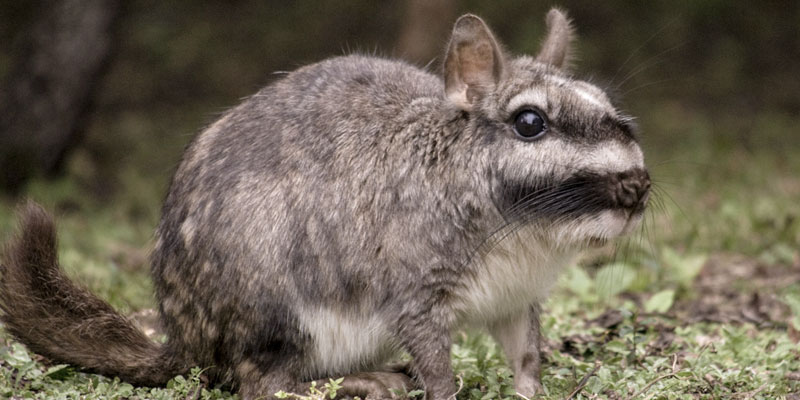Chinchillidae is a family of medium to large-sized chinchillas and viscachas in the order Rodentia, the suborder Hystricomorpha, and the Infraorder Hystricognathi. Little research has been conducted regarding the family’s phylogenetic history. However, recent studies have shown that the family is a monophyletic clade that is related to Dinomyidae, another small mammalian family from South America. The family Chinchillidae includes three extinct genera and three extant genera: the genus Chinchilla consists of the species Chinchilla chinchilla and C. lanigera; genus Lagidium contains Laguidium peruanum, L. viscacia, L. wolffsohni, and L. ahuacaense; while the Lagostomus genus only holds species Lagostomus maximus. The family Chinchillidae first appeared in South America during the Oligocene (34 to 24 million years ago) and now ranges from southern South America, across most of Patagonia and along the central and southern Andes.
Chinchillids commonly live in areas with rocky terrain, open spaces, and shrub-lands. They are known for their ability to jump bipedally, especially when startled, but their main mode of locomotion involves all four limbs. Chinchillas and mountain viscachas (Lagidium) are particularly agile when negotiating the rocky, mountainous terrains they inhabit, but are not strong diggers. These chinchillids have four toes, with weakly developed claws on their hind feet. In comparison, the Plains Viscacha (Lagostomus) is a powerful digger, which lives in colonies in extensive burrow systems excavated beneath its lower-elevation plains habitat. The hind feet of the Plains Viscacha are further reduced to three toes, with strong hind claws. These viscachas are also distinguishable by their striking black and white facial patterns.
All members of Chinchillidae share certain adaptations to rough and rocky terrain, including fleshy foot pads (pallipes), well-developed hind legs, and bushy tails ranging from short to 1/3 of the body length. The forefeet are used for grasping as well as locomotion, with four easily maneuverable toes. Chinchillids are herbivorous and have cheek teeth that continue to grow throughout the individual’s life. The chinchillid jaw is also hystricognathous, based on the absence of an infraorbital plate and the partial passage of muscles through the infraorbital foramen. Additional adaptations include large eyes, moderately large ears, short forelimbs, and long hind limbs suited to bipedal jumping.
Chinchillas are a popular commodity in the pet trade and clothing industry due to their endearing appearance and thick, soft fur. The demand for chinchilla fur in previous centuries has resulted in an extremely low and fragmented wild chinchilla population, which was even believed to have gone extinct for a while. Both chinchilla species are listed as critically endangered on the IUCN Red List of threatened species and little is known about their natural bejaviours, beyond their colonial living style. Mountain and plains viscachas also live in groups, ranging from several individuals to hundreds, in which social interations are facilitated by their large repertoires of vocalisations. Today, mountain viscachas are restricted to remote areas and encounters are infrequent, while plains viscachas come into frequent conflict with ranchers and agriculturalists, whose livestock sustain injuries from stumbling into the holes and tunnels of viscacha colonies and who lose valuable grazing pasture and crops to the notoriously large appetite of the Plains Viscacha – it is said that 10 of these rodents can consume as much as a sheep. No chinchillid species has been studied thoroughly in natural conditions and much remains to be learned about these furry jumpers.






